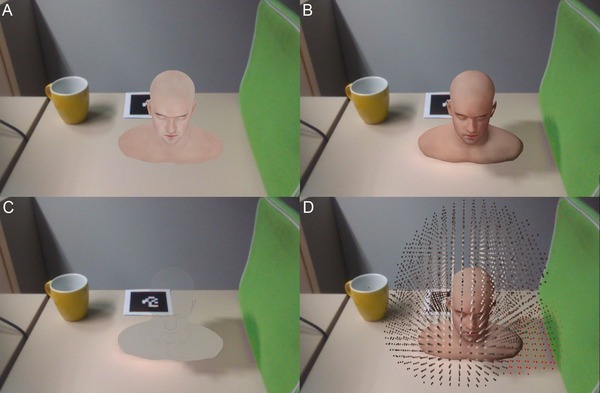Near-Field Illumination for Mixed Reality with Delta Radiance Fields
ACM SIGGRAPH 2013 Posters
 Infinite Head model inserted into a real scene with one reconstructed light source: (a) a synthetic object is inserted without illumination, (b) visible first bounce around the base as well as low resolution shadow (32 propagations, 512^2 VPLs, 11ms per frame), (d) indirect effects without synthetic object for better visualization, (d) visualization of the DLPV (red dots indicate negative values).
Infinite Head model inserted into a real scene with one reconstructed light source: (a) a synthetic object is inserted without illumination, (b) visible first bounce around the base as well as low resolution shadow (32 propagations, 512^2 VPLs, 11ms per frame), (d) indirect effects without synthetic object for better visualization, (d) visualization of the DLPV (red dots indicate negative values).
Abstract
Apart from geometric registration, fusing synthetic objects with a real context requires believable interaction of real and virtual light. Where shadows provide the visual cues to locate a synthetic object in a real scene and transferred light from real light sources let it appear in harmony with its surroundings, the mutual indirect interaction of illumination is a necessary detail to convince an observer that the rendered result is not merely augmented but part of the scene. Such a mixed reality (MR) system has applications in movie production, advertisement of unfinished products or cultural heritage visualization. While there are a range of relighting tools available for offline renderers or static scenes (e.g. photos), interactive MR systems usually disregard proper lighting entirely or greatly simplify shading. A method often employed is to merge virtual light and shadows cast from synthetic objects with a real background with Differential Rendering, leaving out any other light interaction such as indirect light bounces. Attempts have been made to resolve this issue with Instant Radiosity [Knecht et al. 2010; Lensing and Broll 2012]. To suppress flickering, a large number of virtual point lights (VPL) is necessary, drastically taxing execution speed. We propose to model all light, virtual and real, as a unified radiance field instead to avoid performance issues from oversampling and to maintain temporal coherence.
Preview


